Contents
- Harley Davidson Quick Stats
- Harley Davidson Profile Summary
- Images by Harley Davidson Brand Lovers
- Harley Davidson Timeline
- Videos created by Harley Davidson Brand Lovers
- Presentations about Harley Davidson as a Brand
- Articles related to Harley Davidson
- Web site(s) related to Harley Davidson
- Harley Davidson Facebook Fan Page
| Certified Cult Brand | ||||
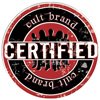 | We have tracked businesses with unprecedented brand loyalty since 2001. A Certified Cult Brand is a designation we hold for brands that fulfill specific market criteria, including upholding the Seven Rules of Cult Brands. | |||
Quick Stats
In 1901 William S. Harley, age 21, completes a blueprint drawing of an engine designed to fit into a bicycle.
In 1983, Harley formed a club for owners of its product using the acronym HOG., for Harley Owners Group.
On August 15, 2006, Harley-Davidson Inc. had its NYSE ticker symbol changed from HDI to HOG.
In 1991, HOG went international, with the first official European HOG Rally in Cheltenham, England. Today, more than one million members and more than 1400 chapters worldwide make HOG the largest factory-sponsored motorcycle organization in the world.
In 2008, HOG celebrated its 25th anniversary in conjunction with the Harley 105th in Milwaukee Wisconsin.
Henry Meyer of Milwaukee, a schoolyard pal of William S. Harley and Arthur Davidson, buys one of the 1903 models directly from the founders.
Licensing of the Harley-Davidson brand and logo accounted for $40 million of the company’s net revenue in 2010.
Harley-Davidson Cult Brand Summary
To say that Harley had fallen on hard times by 1981 would be a drastic understatement. Japanese companies were destroying the company on pricing and Harley-Davidson’s bikes had lost the quality that made them famous.
The executives risked their corporate lives with an $80 million buyout on a turnaround situation that looked almost impossible. But, they couldn’t afford to fail; the whole company’s back was against the wall. They had to make it. The choice was simple: drastically improve the quality of the motorcycles and develop strong customer ties or go out of business.
Harley started copying Japanese production techniques and quality control, and released the new “Evolution” engine in 1983 that put an end to oil leaks and other quality issues.
Given financial constraints, Harley couldn’t engage in a traditional advertising campaign to win over customers. In 1983 CEO Vaughn Beals announced the launch of the Harley Owners Group (H.O.G.), which he saw as a grassroots way to reconnect Harley’s brand and lifestyle with its most faithful customers.
Despite an initial lack of acceptance, within a few years H.O.G. chapters started appearing around the country. The spread of these groups was gorilla marketing at its best: membership was generated primarily from inexpensive promotions at dealerships and word-of-mouth. H.O.G. groups gave enthusiasts a structured way to meet, swap stories, and schedule rides with other evangelists.
Harley made a wise move in requiring every H.O.G. chapter to have a dealership sponsor. The result of this stipulation was a tighter relationship between Harley dealers and the customers, as well as an increase in parts and merchandise sales.
They didn’t stop with creating members groups. They started sponsoring rallies around the country. In doing so, not only did they solidify their communities, but they also used the rallies as a killer sales tool. They bring motorcycles to the rallies for people to tryout. This concept reaches its apex each year at Bike Week in Daytona Beach and the Sturgis Rally and Races in South Dakota. Collectively, the events attract over half a million Harley enthusiasts. Harley takes feedback its employees receive at these events very seriously. Opinions they receive from customers affect what is produced in product lines and the way they run their rallies. This desire to appeal to the customer has been extended to the point that Harley offers the option of customizing their motorcycles. This allows Harley to rack up higher-margin sales, while allowing consumers who buy a custom Harley feel like they are not only joining the “Harley nation,” but that they are also exercising their own individuality.
In creating these events, and paying attention to its customers, what Harley is ultimately selling through its motorcycles is the opportunity to experience the feelings of raw freedom and empowerment that one receives from strapping on some leather and riding a bike down the open road. These are feelings common to Americans of all ages, races, and backgrounds.
Harley-Davidson Timeline
1901- William S. Harley, age 21, completes a blueprint drawing of an engine designed to fit into a bicycle.
1903- William S. Harley and Arthur Davidson make available to the public the first production Harley-Davidson® motorcycle. The bike was built to be a racer, with a 3-1/8 inch bore and 3-1/2 inch stroke. The factory in which they worked was a 10 x 15-foot wooden shed with the words “Harley-Davidson Motor Company” crudely scrawled on the door. Arthur’s brother Walter later joins their efforts.
Henry Meyer of Milwaukee, a schoolyard pal of William S. Harley and Arthur Davidson, buys one of the 1903 models directly from the founders.
1904- The first Harley-Davidson Dealer, C.H. Lang of Chicago, IL, opens for business and sells one of the first three production Harley-Davidson motorcycles ever made.
1905- On July 4th, a H-D motorcycle wins a 15 mile race in Chicago with a time of 19:02. In Milwaukee, the first full-time employee is hired.
1906 – A new factory, measuring 28 x 80 feet, is built on the Chestnut St. site, later renamed Juneau Avenue. Staff size is increased to six full-time employees. Also, the first motorcycle catalog is produced by the Company and the nickname “Silent Gray Fellow” is used for the first time.
1907 – William A. Davidson, brother to Arthur and Walter Davidson, quits his job as tool foreman for the Milwaukee Road railroad and joins the Motor Company.
Harley-Davidson Motor Company is incorporated on September 17th. The stock is split four ways between the four founders, and staff size has more than doubled from the previous year to eighteen employees. Factory size is doubled as well. Dealer recruitment begins, targeting the New England region.
1908 – Walter Davidson scores a perfect 1,000 points at the 7th Annual Federation of American Motorcyclists Endurance and Reliability Contest. Three days after the contest, Walter sets the FAM economy record at 188.234 miles per gallon. Word of Harley-Davidson’s extremely tough motorcycle spreads rapidly.
The first motorcycle sold for police duty is delivered to the Detroit, MI, Police Department.
1909 – The six-year-old Harley-Davidson Motor Company introduces its first V-twin powered motorcycle. With a displacement of 49.5 cubic inches, the bike produces seven horsepower. The image of two cylinders in a 45-degree configuration would fast become one of the most enduring icons of Harley-Davidson history. Also available for the first time from the Motor Company are spare parts for motorcycles.
1910 – The famed “Bar & Shield” logo is used for the first time. It is trademarked at the U.S. Patent office one year later.
At least seven different first place finishes are captured at races, endurance contests and hillclimbs across America. All seven winners are riding Harley-Davidson® motorcycles.
1911 – The “F-head” engine becomes a workhorse of the Harley-Davidson motorcycle until 1929.
1912 – Construction begins on what will become the six story headquarters and main factory building at Juneau Ave. in Milwaukee. A separate Parts and Accessories Department is formed.
H-D exports motorcycles to Japan, marking the first ever sales outside of the U.S. Dealer network grows to over 200 nationwide.
1913 – The Racing Department is formed, with William Ottaway as its first Assistant Engineer to racing engineer William S. Harley. Also, the Forecar delivery van is offered for the first time.
1914 – Sidecars are made available to Harley-Davidson buyers. Clutch and brake pedals now available on F-head singles and twins.
The Motor Company formally enters motorcycle racing this year. The first Racing Engineer is William S. Harley. Within a few short years, team Harley-Davidson is referred to informally as the “Wrecking Crew” because of their incredible dominance of the sport.
The Two-Speed rear hub transmission is introduced for two years only in the Model 10F. Patented by William S. Harley, it was effective but discontinued in order to further improve drivetrain function in 1915 with a three-speed design.
1915 – Harley-Davidson motorcycles are now available with three speed sliding-gear transmissions with final and primary drive on the same side.
1916 – The Enthusiast begins its reign as the longest continuously published motorcycle magazine in the world.
1917 – During this year, roughly one-third of all Harley-Davidson motorcycles produced are sold to the U.S. military. The Quartermasters School, a department of Harley-Davidson devoted to training military mechanics on Harley-Davidson motorcycles, opens for business in July. It will later become the Service School.
The sale of Harley-Davidson bicycles begins. Individual components are made by the Davis Sewing Machine Co. of Dayton, Ohio. The bicycles are sold through the H-D dealer network.
1918 – Almost half of all Harley-Davidson motorcycles produced are sold for use by the U.S. military in World War I. At War’s end, it is estimated that the Army used some 20,000 motorcycles in their efforts, most of which were Harley-Davidsons. One day after the signing of the Armistice, Corporal Roy Holtz of Chippewa Falls, Wis., is the first American to enter Germany. He is riding a Harley-Davidson.
1919 – The 37 cubic inch opposed twin cylinder Sport model is introduced and gains great popularity overseas. Unique not only for the cylinder configuration, which was directly opposed and flat, the Sport quickly earns a reputation for being uncommonly quiet.
1920 – By 1920, Harley-Davidson is the largest motorcycle manufacturer in the world. New Harley-Davidson® motorcycles can be purchased from over 2,000 dealers in 67 countries worldwide.
Leslie “Red” Parkhurst breaks 23 speed records on a Harley-Davidson 61 cubic inch racing motorcycle. Also, the “hog” association starts when the racing team’s mascot, a pig, is carried on a victory lap after each race won by the team.
1922 – The first 74 cubic inch V-twin engine is introduced on the JD and FD models. Harley-Davidson dealerships are now found in sixty-seven countries.
Harley-Davidson riders sweep all eight National Championship races.
1925 – Gas tanks on all models now have a distinct teardrop shape. This basic appearance is set for all subsequent Harley-Davidson motorcycles.
Joe Petrali begins racing for Harley-Davidson. He would become one of the most successful dirt-track racers for Harley-Davidson, and one of the most successful racers of all time.
1926 – Single-cylinder motorcycles are again sold by Harley-Davidson for the first time since 1918. Models A, AA, B, and BA are available in side-valve and overhead-valve engine configurations.
1928 – The first Harley-Davidson two cam engine is made available to the public on the JD series motorcycles. The bike is capable of top speeds between 85 – 100 mph.
Front wheel brakes are now available on all Harley-Davidson motorcycles.
1929 – The 45 cubic inch V-twin engine (later to be known as the “flathead”) is introduced on the D model. The engine proves to be so reliable that variations of it are available on Harley-Davidson motorcycles as late as 1973.
1930 – Bill Davidson, Jr. wins the Jack Pine endurance contest with 997 points of 1,000. All individual class winners are riding Harley-Davidson® motorcycles.
1931 – All of Harley-Davidson’s remaining American competition is now gone except Indian (Hendee Manufacturing). Indian and Harley-Davidson are the only two American motorcycle manufacturers until 1953.
1932 – The 45 cubic inch-driven, three-wheeled Servi-car begins its 41 year run as a popular commercial and police vehicle.
In dirt track racing, Harley-Davidson racer Joe Petrali begins a five-year consecutive streak of winning the AMA Grand National Championship. Petrali also wins the National Hill-Climb Championships for 1932 to 1935.
1933 – An art-deco “eagle” design is painted on all gas tanks. This marks the beginning of graphic designs on Harley-Davidson motorcycles (with the exception of previously special order-only paint schemes). This styling decision was made in part to stimulate the low sales numbers caused by the Great Depression.
1935 – The Japanese motorcycle industry is founded as a result of Harley-Davidson licensing blueprints, tools, dies and machinery to the Sankyo Company of Japan. The result is the Rikuo motorcycle.
Joe Petrali and his Harley-Davidson peashooter win all thirteen of the American Motorcycle Association National Championship dirt track races. Petrali breaks four records in the process.
1936 – Harley-Davidson introduces the EL, an overhead valve, 61 cubic inch powered bike. With increased horsepower and bold styling changes, the motorcycle quickly earns the nickname of “Knucklehead,” due to the shape of its rocker boxes. The same year, the Motor Company introduces a 80 cubic inch side valve engine.
1937 – The first WL models are produced. Joe Petrali sets a new land speed record of 136.183 mph on a modified Harley-Davidson 61 cubic inch overhead valve-driven motorcycle. . The same day, he also breaks the record for 45 cubic inch engine motorcycles.
1938 – The Jack Pine Gypsies Motorcycle Club holds the first Black Hills Rally in Sturgis, SD.
On the 3.2 mile beach course at Daytona, FL, Ben Campanale wins the first of two consecutive victories at the Daytona 200 on a Harley-Davidson WLDR.
1940 – Babe Tancrede is the winner at the Daytona 200, riding a WLDR model.
1941 – America is plunged into World War II. Production of civilian motorcycles is almost entirely suspended in favor of military production. The Service School is converted back to the Quartermasters School for the training of military mechanics.
The FL series premieres.
1942 – Among other motorcycles made for the Army, H-D produces the unique XA 750, a motorcycle with horizontally opposed cylinders and shaft drive, designed for desert use. The contract is cancelled early due to war combat moving out of North Africa. Only 1,011 XA’s are built.
1943 – Harley-Davidson receives the first of its four Army-Navy “E” Awards for excellence in wartime production. Overseas, many American servicemen get their first exposure to Harley-Davidson motorcycles, something they would not forget when they would return stateside.
1945 – Harley-Davidson produces almost 60,000 WLA models during the war for military use. World War II ends. Wasting no time, production of civilian motorcycles resumes in November.
1946 – Harley-Davidson introduces the 45 cubic inch flathead WR racing motorcycle. It proves to be one of the best racing motorcycles ever built.
1947 – Attendees at the year’s Dealers Convention in Milwaukee are given a train ride to a “secret destination,” which turns out to be the newly purchased plant on Capitol Drive. The plant was formerly the A.O. Smith Propeller Plant, created during the war. Harley-Davidson uses the plant as a large machine shop, shipping the new parts to Juneau Ave. for final assembly.
Harley-Davidson begins selling what will become the classic black leather motorcycle jacket.
Harley-Davidson dirt track racer Jimmy Chann wins the first of three consecutive AMA Grand National Championships.
1948 – New features are added to the 61 and 74 overhead valve engines, including aluminum heads and hydraulic valve lifters. Also new are the one piece, chrome plated rocker covers shaped like cake pans. The nickname “Panhead” only seemed logical.
Production of American-made lightweight motorcycles begins with the model S. Various versions will be sold until 1966.
1949 – Hydraulic front forks first appear on the new Hydra-Glide models.
1950 – Larry Headrick wins the AMA Grand National Championship for Harley-Davidson in dirt track racing.
Harley-Davidson riders win 18 of 24 National Championships and set six new racing records.
1952 – The side-valve K model is introduced with an integrated engine & transmission to compete with smaller, sportier motorcycles coming mainly from Great Britain. The K will eventually evolve into the Sportster.
1953 – Harley-Davidson celebrates its 50th Anniversary in style. An attractive logo is created, depicting a “V” in honor of the engine which had brought the Company so far, with a bar overlaid reading “Harley-Davidson” and the words, above and below, “50 years–American made.” A medallion version of this logo is placed on the front fenders of the 1954 models.
Hendee Manufacturing, the creator of the Indian motorcycle, goes out of business. Harley-Davidson would be the sole U.S. motorcycle manufacturer for the next 46 years.
1954 – Dirt track racer Joe Leonard wins the AMA Grand National Championship. Over the next eight years, the Grand National Championship will be won by Harley-Davidson racers.
1955 – This year begins a seven-year consecutive run of victories at the Daytona 200. The victories will be shared by racers Brad Andres, Johnny Gibson, Joe Leonard and Roger Reiman. All ride Harley-Davidson KR models. Reiman’s victory in 1961 is on the new speedway course.
1956 – The new young star Elvis Presley poses for the cover of the MayEnthusiast sitting on a 1956 model KH.
1957 – The motorcycling public met a new motorcycle called the Sportster®. It premiers as a 55 cubic inch overhead valve engine, and within one year of its debut, becomes known as the first of the “Superbikes.” Another Harley-Davidson tradition and legend is born.
1958 – The first rear brakes and hydraulic rear suspensions appear on the Duo-Glide.
Racer Carroll Resweber wins the first of four AMA Grand National Championships.
1960 – The Harley-Davidson Topper motor scooter is introduced and is the only scooter platform the Motor Company ever produced.
Harley-Davidson purchases a half interest in Aeronatica-Macchi, forming Aermacchi Harley-Davidson, a European division that will produce small, single cylinder motorcycles.
In this year of Brad Andres’ 1st place finish at the Daytona 200, the top 14 finishers are also riding Harley-Davidson 750 KR models.
1961 – Introduction of the Sprint model.
1962 – Harley-Davidson purchases 60 percent of the stock in the Tomahawk Boat Manufacturing Company. H-D recognizes the rising relevance of fiberglass in motorcycle production, and begins manufacturing its own components. As a result, the Tomahawk Division is established and is operational as a Harley-Davidson facility by 1963.
1963 – Ralph White resumes the winning of the Daytona 200 for Harley-Davidson, again on a 750 KR motorcycle.
1964 – Roger Reiman wins the AMA Grand National Championship for Harley-Davidson. Reiman also scores the first of back-to-back Daytona 200 victories on a 750 KR.
The three-wheeled Servi-Car becomes the very first Harley-Davidson motorcycle to receive an electric starter.
1965 –The Electra-Glide® replaces the Duo-Glide and is updated with electric starter. The Electra-Glide is the first FL available with electric start, and the Sportster® line would receive electric starters soon after.
In a Streamliner powered by a 250cc Sprint CR racing engine, George Roeder shatters the speed records for Class A and Class C runs, averaging 177 miles per hour.
Harley-Davidson dirt track racer Bart Markel wins the AMA Grand National Championship in 1965 and 1966.
1966 – The first of the “Shovelhead” engines is introduced on the Electra-Glide models, replacing the Panhead.
1968 – Cal Rayborn wins the first of back-to-back victories at the Daytona 200 on a 750 KR model.
1969 – Harley-Davidson merges with the American Machine and Foundry Company (AMF), a longtime producer of leisure products.
Mert Lawill wins the AMA Grand National Championship for team Harley-Davidson in dirt track racing.
1970 – In consideration of new AMA rules for Class C racing, a new Sportster®-based motorcycle, the XR-750 racer is introduced.
1971 – In response to the customizing craze, Harley-Davidson introduces the FX 1200 Super Glide®, which combined a sporty front end (similar to that of the XL series) with the frame and powertrain of the FL series. A new class of motorcycle, the cruiser, is born.
First year of Harley-Davidson snowmobile production.
1972 – The new, more powerful, more reliable aluminum alloy XR-750 debuts. It becomes the dominant dirt track racer through the next three decades. Dirt track racer Mark Brelsford wins the AMA Grand National Championship on the XR-750 this year.
1973 – Motorcycle production is upgraded when all assembly operations are moved to a modern 400,000 square foot plant in York, Penn. All other production operations remain in Milwaukee and Tomahawk. The Capitol Drive plant in Milwaukee begins production of engines.
1975 – The first of four more consecutive years of Harley-Davidson AMA Grand National Championships in dirt track racing. Gary Scott wins in 1975. The following three years are won by racing legend Jay Springsteen.
1977 – Harley-Davidson introduces the FXS Low Rider® to the public in Daytona Beach. With drag style handlebars, unique engine and paint treatments, the Low Rider lives up to its name by placing the rider in a lowered seating position than was typical. Later in the same year, Willie G. Davidson’s dynamic version of the Sportster, the Cafe Racer, is released.
1979 – Introduction of the FXEF Fat Bob, “Fat” because of the dual gas tanks, “Bob” for the bobbed fenders.
1980 – Harley-Davidson debuts the FLT with its vibration dampening, rubber-isolated drivetrain and unique trailing front fork. The FLT also debutes an engine and five-speed transmission that are hard bolted together.
A kevlar belt replaces the chain as the final drive. The belt is cleaner running, and needs less adjustments and maintenance. It isn’t long before belt final drive is standard on all Harley-Davidson® motorcycles.
The AMA Grand National Championship in dirt track racing goes to yet another Harley-Davidson racer, Randy Goss.
In honor of the historic Sturgis motorcycle rally, Harley-Davidson releases the FXB Sturgis model, employing belt drive, black chrome appointments and 80 cubic inch engine.
The FXWG Wide Glide is introduced for the 1980 model year.
1981 – On February 26, thirteen Harley-Davidson senior executives sign a letter of intent to purchase Harley-Davidson Motor Company from AMF. By mid-June, the buyback is official, and the phrase “The Eagle Soars Alone” becomes a rallying cry.
Scott Parker begins racing for team Harley-Davidson on the AMA dirt track circuit. He will become the most successful racer in Harley-Davidson history, accumulating 93 career victories and, more incredibly, winning 9 Grand National Champion titles in a 10 year period.
1982 – More innovations demonstrate a new commitment to quality, such as the FXR/FXRS Super Glide® II with its rubber-isolated, five-speed powertrain and the welded and stamped frame for the new Sportster® models.
The top three finishers in the AMA Grand National Championship are Ricky Graham, Jay Springsteen and Randy Goss. This begins a two year run of dirt track Championship wins for Harley-Davidson. Goss takes the Championship in 1983.
The Materials As Needed (MAN) application is introduced to production. Generally, this means that parts and raw materials are purchased and built only as they are required. This dramatically lowers production costs and improves quality.
1983 – Harley-Davidson successfully petitions the International Trade Commission (ITC) for tariff relief, which is granted April 1, 1983. The tariff, scheduled to end five years later, is placed on all imported Japanese motorcycles 700cc or larger as a response to Japanese motorcycle manufacturers stockpiling inventories of unsold motorcycles in the United States.
One of Harley-Davidson’s most unique endeavors begins: Harley Owners Group®. Fondly referred to as H.O.G.®, the Group immediately becomes the largest factory-sponsored motorcycle club in the world. Within six years, H.O.G. membership soars to more than 90,000. By the year 2000, it exceeds 500,000 members.
Dirt track racer Randy Goss wins the AMA Grand National Championship this year.
1984 – Harley-Davidson unveils the 1340cc V²® Evolution® engine on five models including the all-new Softail®. The result of seven years of development, the Evolution engine produces more power at every speed, runs cooler, cleaner and is oil-tight. Also witnessed is the debut of the Softail design and its trend-setting method of “hiding” the motorcycle’s rear shock absorbers.
1986 – In another bold styling and engineering move, Harley-Davidson releases the Heritage Softail®.
The Motor Company is listed on the American Stock Exchange, the first time Harley-Davidson is publicly traded since 1969, the year of the AMF merger.
The Sportster® motorcycle line receives the Evolution V-twin engine.
To diversify its holdings, Harley-Davidson purchases Holiday Rambler Corporation, producer of quality motor homes.
1987 – Harley-Davidson is listed on the New York Stock Exchange.
Harley-Davidson makes both business and American history. H-D petitions the International Trade Commission for early termination of the five-year tariffs on heavyweight motorcycles. In effect, the move demonstrated confidence in H-D’s ability to compete in the marketplace.
Harley-Davidson begins the “Buy Back Program,” for the XLH 883 Sportster, which offers full trade-in value within two years on either a model FL or FX.
1988 – The springer front end returns in the FXSTS Springer® Softail®. Also introduced is the Sportster 1200. Harley-Davidson celebrates its 85th Anniversary with a Homecoming in Milwaukee, attended by over 60,000 enthusiasts.
The Harley-Davidson Traveling Museum hits the road, displaying memorabilia, classic Harley-Davidson motorcycles and the rich history of the Harley-Davidson rider.
Scott Parker wins the first of his nine AMA Grand National Championships. His total domination is unprecedented in the history of the sport of dirt track motorcycle racing.
1990 – Upon its introduction, the FLSTF Fat Boy® almost instantaneously becomes a modern legend of motorcycle design.
1991 – Installation of a $31 million state of the art paint facility begins at the York, PA, factory. It becomes fully operational in 1992.
The Dyna line of motorcycles debuts with the 1991 FXDB Dyna Glide Sturgis®.
1993 – Harley-Davidson celebrates its 90th Anniversary in Milwaukee with a Family Reunion. An estimated 100,000 people ride in a parade of motorcycles.
Harley-Davidson buys a minority interest in the Buell Motorcycle Company. Erik Buell created the Company to manufacture American sport motorcycles using Harley-Davidson® XL 883 and 1200 engines.
1994 – Harley-Davidson enters Superbike racing with the introduction of the VR1000, a dual overhead cam, liquid-cooled motorcycle.
The classically-styled FLHR Road King® is introduced.
1995 – The 30th Anniversary Ultra Classic® Electra Glide® becomes the first production Harley-Davidson motorcycle to include sequential port electronic fuel injection.
1996 – A new, state-of-the-art Parts and Accessories Distribution Center opens in Franklin, WI. By the beginning of 1997, all inventory is moved from the original warehouse at Juneau Avenue to the new 250,000-sq.-ft. facility.
1997 – A new 217,000-sq.-ft. Product Development Center opens next to the Capitol Drive plant in Milwaukee. The building is dedicated to Willie G. Davidson.
Powertrain Operations at Capitol Drive expanded its capacity by moving FL engine and transmission production to a newly purchased plant located in Menomonee Falls. XL engines and transmissions, as well as Genuine Parts Manufacturing, remain at Capitol Drive.
A new 330,000-sq.-ft. plant in Kansas City produces its first Sportster.
1998 – Harley-Davidson celebrates its 95th Anniversary. 140,000 plus riders are warmly received by Milwaukee to help with the celebration.
A new assembly facility opens in Manaus, Brazil, the first operations outside of the U.S.
Harley-Davidson buys a remaining 49% interest in Buell Motorcycle Company. Erik Buell is named Chairman of Buell operations.
1999 – The Touring and Dyna motorcycle families receive the new Twin Cam 88® engine.
2000 – The FXSTD Softail® Deuce™ is introduced to the immediate delight of riders and the motorcycle media.
The 2000 model year Softail® models are outfitted with the Twin Cam 88B™ engine, a counter-balanced version of the Twin Cam 88.
Fuel injection is unveiled as a feature new to the Softail line of motorcycles for the 2001 model year.
Buell introduces the Blast®, a single-cylinder motorcycle, for the 2000 model year. The Blast receives excellent reviews. It’s introduced in tandem with the Rider’s Edge® Academy of Motorcycling, a beginner’s rider course available through Harley-Davidson and Buell dealerships.
2001 – The VRSCA V-Rod® is introduced for the 2002 model year. Inspired by the VR-1000 racing motorcycle, the V-Rod is Harley-Davidson’s first motorcycle to combine fuel injection, overhead cams and liquid cooling, and delivers 115 horsepower.
Harley-Davidson Racing announces the latest addition to the team: 17 year old Jennifer Snyder, the first woman to win a national event in the Formula USA National Dirt Track Series.
Harley-Davidson announces expansions at the Product Development Center (Milwaukee), as well as Tomahawk, WI, and York, PA, facilities.
2002 – The all-new Buell® Firebolt® storms onto the scene.
The Open Road Tour debuts in Atlanta, GA, in July to celebrate the upcoming Harley-Davidson 100th Anniversary.
2003 – Buell Motorcycle Company unleashes the Lightning® XB9S.
More than 250,000 people come to Milwaukee for the final stop of the Open Road Tour and the Harley-Davidson 100th Anniversary Celebration and Party.
2004 – For the 2004 model year, the Sportster® family models receive rubber engine mounting, a new frame, and a wider rear tire. Some Sportster® models receive a redesigned gas tank.
The FLHRSI Road King® Custom is introduced. With its low rear suspension and wide handlebars, the FLHRSI brings a beach look to a classic Harley-Davidson motorcycle.
Andrew Hines of the Screamin’ Eagle®/Vance & Hines Harley-Davidson drag racing team clinches his first NHRA Powerade Pro Stock Motorcycle Championship at age 21, the youngest champion in NHRA history.
2005 – The XL 883L Sportster® 883 Low brings a lowered seating position to the Sportster® line.
The FLSTNI Softail® Deluxe adds a sleek look to the Softail® line and a paint scheme reminiscent of 1939 Harley-Davidson motorcycles. Also, the FLSTSC/I Softail® Springer® Classic revives looks from the late 1940s.
Andrew Hines wins his second straight NHRA Powerade Pro Stock Motorcycle Championship. G.T. Tonglet, also of the Screamin’ Eagle®/Vance & Hines Harley-Davidson team, places second.
Harley-Davidson and the Muscular Dystrophy Association (MDA) mark the 25th anniversary of their partnership.
2006 – The first of the 6-speed transmissions are made available on 2006 model year Dyna™ motorcycles. Also joining the Dyna™ family is the FXDB/I Street Bob™.
The 2006 model year includes the all-new FLHX/I Street Glide™, a lower profile touring motorcycle.
Harley-Davidson unveils plans for an all-new museum in Milwaukee, scheduled for opening in 2008.
Harley-Davidson appoints Beijing Feng Huo Lun (FHL) as the first authorized Harley-Davidson dealer on mainland China.
2007 – Eddie Krawiec joins the Screamin’ Eagle/Vance & Hines Harley-Davidson NHRA Pro Stock Team.
Kenny Coolbeth wins his second consecutive AMA Flat Track Twins Championship.
The XL 1200N Nightster arrives on the scene with black rims, fork gaiters, and side mount license plate holder.
Announced for the 2008 model year, the new FXCWC Rocker introduces Harley-Davidson’s first swingarm-mounted rear fender and 2-into-1 Trick seat.
2008 – The Touring family now has an all new frame, providing longer wheelbase, lower seating position and better maneuverability.
The all new Harley-Davidson Museum opens in Milwaukee on July 12. Located at 6th and Canal streets, the Museum showcases hundreds of classic and custom motorcycles, interactive exhibits and never-before-seen films and photographs.
In keeping with tradition, hundreds of thousands of riders from around the world converge on Milwaukee to celebrate Harley-Davidson’s 105th Anniversary. Riders and dealers raise more than $6.7 million for MDA. Entertainment includes the Foo Fighters and Bruce Springsteen. That same weekend, HOG marks 25 years with its own party.
Kenny Coolbeth clinches his third consecutive Grand National Championship. On the drag strip, Eddie Krawiec wins the fourth NHRA Pro Stock title for Harley-Davidson in five years.
2009 – Harley-Davidson announces expansion into India.
The AMA Flat Track team wins yet another Grand National Championship, this time with Jared Mees at the top.
The 2009 model year brings the first three-wheeler for public purchase in the new FLHTCUTG Tri Glide Ultra Classic. Also new is the history-inspired Cross Bones, a bobbed factory custom.
2010 – The XL Forty-Eight is introduced, recalling the raw, custom Sportsters of earlier days.
Seth Enslow on a Harley-Davidson XR1200 breaks the world record for a long distance motorcycle jump on a Harley-Davidson at 183.7 feet. Previously, the record was proudly held by Bubba Blackwell (1999) and Evel Kneivel (1975).
Images of Harley-Davidson Brand Lovers
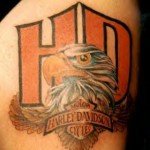 |
 |
 |
 |
 |
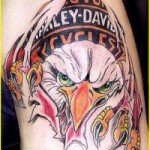 |
 |
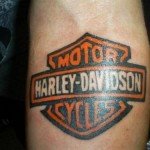 |
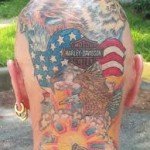 |
 |
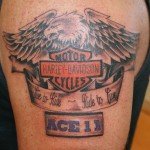 |
 |
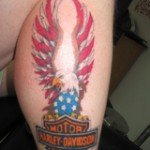 |
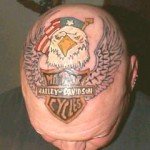 |
 |
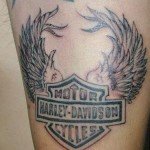 |
 |
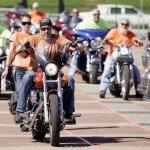 |
 |
 |
 |
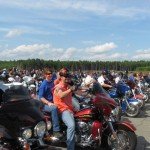 |
 |
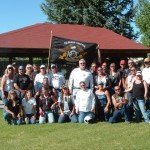 |
 |
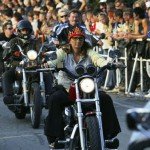 |
Videos Created By Harley Davidson Brand Lovers
Presentations About Harley Davidson As a Brand
Articles related to Harley Davidson
Happy 105th Anniversary Harley. by Salim Bueno
Lifestyle Brand Study Brand Channel, by Barry Silverstein
Harley Davidson Web Site
http://www.harley-davidson.com/
Harley Owners Group
Official Harley Owners Group Website
Twitter
http://twitter.com/#!/harleydavidson
Facebook Fan Page
http://www.facebook.com/harley-davidson
Browse Cult Brands | ||||
 | 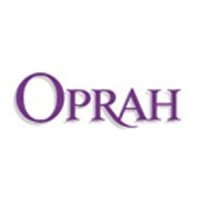 | 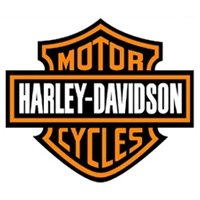 | 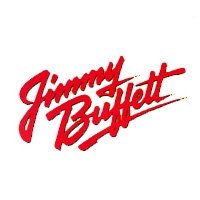 | 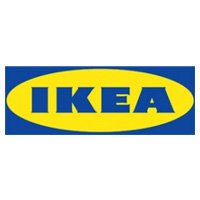 |
 |  | 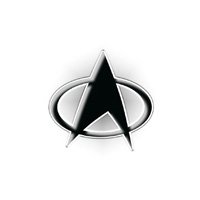 | 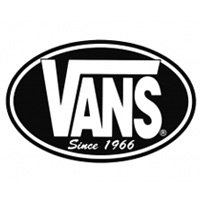 |  |
 | 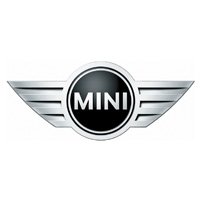 |  | ||

